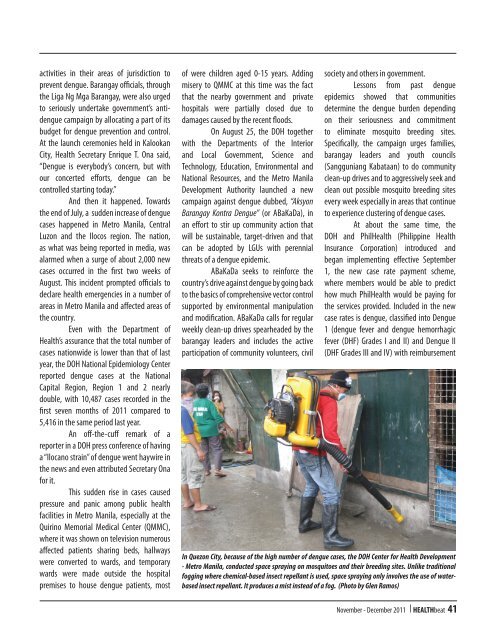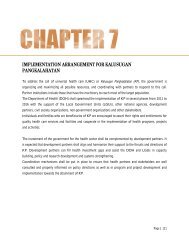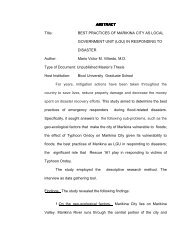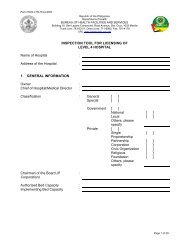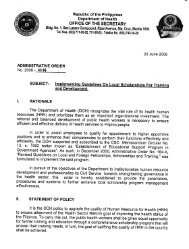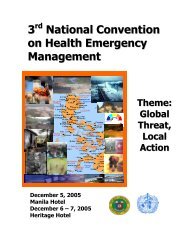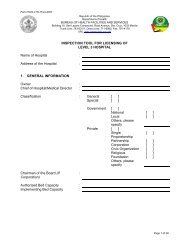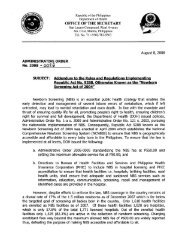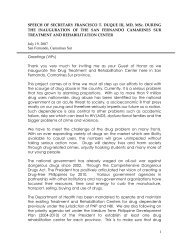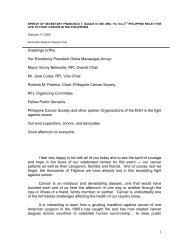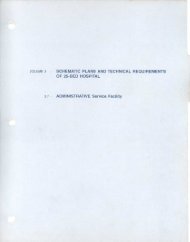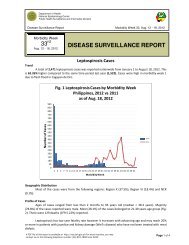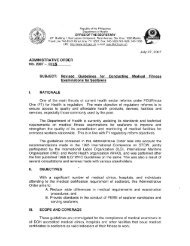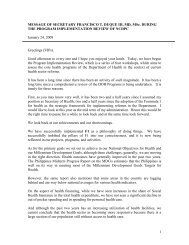Issue No. 67 - November to December 2011 - DOH
Issue No. 67 - November to December 2011 - DOH
Issue No. 67 - November to December 2011 - DOH
- No tags were found...
Create successful ePaper yourself
Turn your PDF publications into a flip-book with our unique Google optimized e-Paper software.
activities in their areas of jurisdiction <strong>to</strong>prevent dengue. Barangay officials, throughthe Liga Ng Mga Barangay, were also urged<strong>to</strong> seriously undertake government’s antidenguecampaign by allocating a part of itsbudget for dengue prevention and control.At the launch ceremonies held in KalookanCity, Health Secretary Enrique T. Ona said,“Dengue is everybody’s concern, but withour concerted efforts, dengue can becontrolled starting <strong>to</strong>day.”And then it happened. Towardsthe end of July, a sudden increase of denguecases happened in Metro Manila, CentralLuzon and the Ilocos region. The nation,as what was being reported in media, wasalarmed when a surge of about 2,000 newcases occurred in the first two weeks ofAugust. This incident prompted officials <strong>to</strong>declare health emergencies in a number ofareas in Metro Manila and affected areas ofthe country.Even with the Department ofHealth’s assurance that the <strong>to</strong>tal number ofcases nationwide is lower than that of lastyear, the <strong>DOH</strong> National Epidemiology Centerreported dengue cases at the NationalCapital Region, Region 1 and 2 nearlydouble, with 10,487 cases recorded in thefirst seven months of <strong>2011</strong> compared <strong>to</strong>5,416 in the same period last year.An off-the-cuff remark of areporter in a <strong>DOH</strong> press conference of havinga “Ilocano strain” of dengue went haywire inthe news and even attributed Secretary Onafor it.This sudden rise in cases causedpressure and panic among public healthfacilities in Metro Manila, especially at theQuirino Memorial Medical Center (QMMC),where it was shown on television numerousaffected patients sharing beds, hallwayswere converted <strong>to</strong> wards, and temporarywards were made outside the hospitalpremises <strong>to</strong> house dengue patients, mos<strong>to</strong>f were children aged 0-15 years. Addingmisery <strong>to</strong> QMMC at this time was the factthat the nearby government and privatehospitals were partially closed due <strong>to</strong>damages caused by the recent floods.On August 25, the <strong>DOH</strong> <strong>to</strong>getherwith the Departments of the Interiorand Local Government, Science andTechnology, Education, Environmental andNational Resources, and the Metro ManilaDevelopment Authority launched a newcampaign against dengue dubbed, “AksyonBarangay Kontra Dengue” (or ABaKaDa), inan effort <strong>to</strong> stir up community action thatwill be sustainable, target-driven and thatcan be adopted by LGUs with perennialthreats of a dengue epidemic.ABaKaDa seeks <strong>to</strong> reinforce thecountry’s drive against dengue by going back<strong>to</strong> the basics of comprehensive vec<strong>to</strong>r controlsupported by environmental manipulationand modification. ABaKaDa calls for regularweekly clean-up drives spearheaded by thebarangay leaders and includes the activeparticipation of community volunteers, civilsociety and others in government.Lessons from past dengueepidemics showed that communitiesdetermine the dengue burden dependingon their seriousness and commitment<strong>to</strong> eliminate mosqui<strong>to</strong> breeding sites.Specifically, the campaign urges families,barangay leaders and youth councils(Sangguniang Kabataan) <strong>to</strong> do communityclean-up drives and <strong>to</strong> aggressively seek andclean out possible mosqui<strong>to</strong> breeding sitesevery week especially in areas that continue<strong>to</strong> experience clustering of dengue cases.At about the same time, the<strong>DOH</strong> and PhilHealth (Philippine HealthInsurance Corporation) introduced andbegan implementing effective September1, the new case rate payment scheme,where members would be able <strong>to</strong> predicthow much PhilHealth would be paying forthe services provided. Included in the newcase rates is dengue, classified in<strong>to</strong> Dengue1 (dengue fever and dengue hemorrhagicfever (DHF) Grades I and II) and Dengue II(DHF Grades III and IV) with reimbursementIn Quezon City, because of the high number of dengue cases, the <strong>DOH</strong> Center for Health Development- Metro Manila, conducted space spraying on mosqui<strong>to</strong>es and their breeding sites. Unlike traditionalfogging where chemical-based insect repellant is used, space spraying only involves the use of waterbasedinsect repellant. It produces a mist instead of a fog. (Pho<strong>to</strong> by Glen Ramos)<strong>No</strong>vember - <strong>December</strong> <strong>2011</strong> I HEALTHbeat 41


